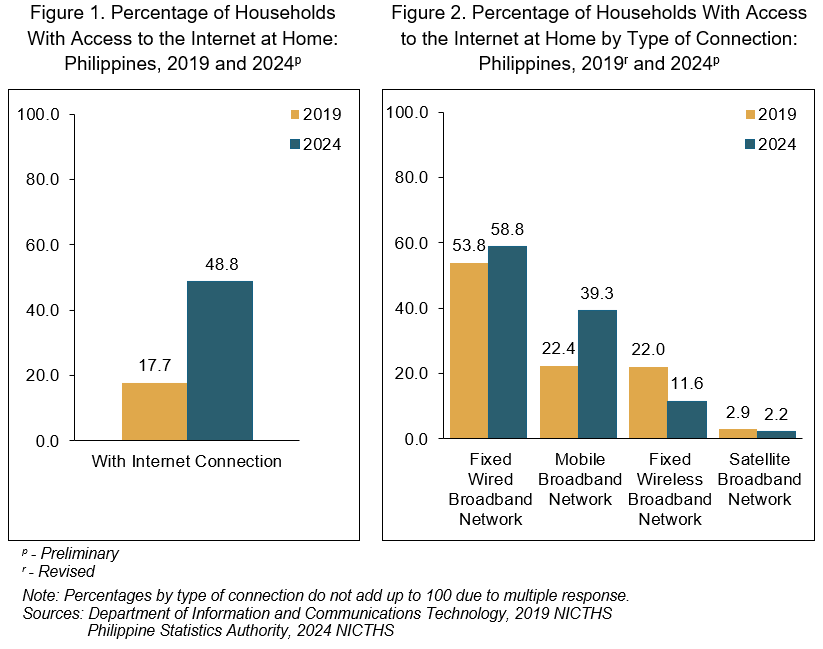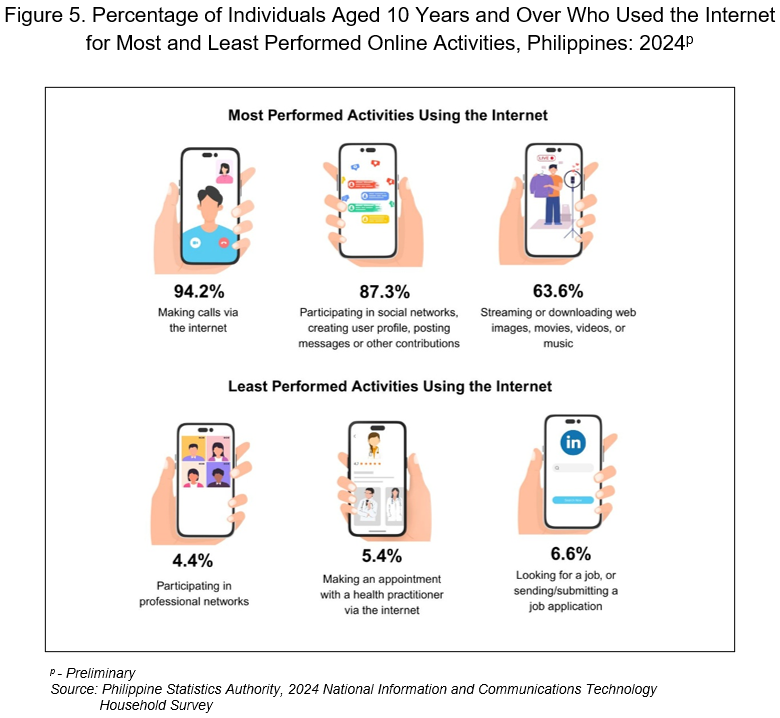
By Dean Aubrey Caratiquet
Internet access has proven to be an indispensable tool in revolutionizing daily lives in the diaspora, especially in developing countries like the Philippines, where the citizenry is able to tap into a vast cyberspace to access services, consume media, and communicate with one another.
What was initially a byproduct of necessity during the height of mobility restrictions brought about by the Covid-19 pandemic in 2020 has now become ingrained in the hearts and households of Filipinos, young and old alike.
In the 2024 National Information and Communications Technology Household Survey (NICTHS), the Philippine Statistics Authority (PSA) and Department of Information and Communications Technology (DICT) reported 48.8% (13.56 million) of total households in the country have internet access.
This translates to an increase of 31.1 percentage points from the percentage of households with access to internet at home in 2019, at 17.7%.
Across regions, National Capital Region (NCR) and Central Luzon had the highest percentage of households with access to the internet at home at 68.7 percent and 61.3 percent, respectively.
Of these households hooked up to the web, more than half (58.8%) are connected via fixed wired broadband network. The remaining households utilize mobile broadband network (39.3%), fixed wireless broadband network (11.6%), and satellite broadband network (2.2%) as their means of connecting to the internet.
The PSA moreover also reported a decline in monthly internet expenditure that Filipino households shell out to remain connected to the web, averaging P1,069.10 per month in 2024 from P1,280.59 in 2019; a reduction of P211.49 in monthly internet fees in a span of five years.

Increased online access among Filipino populace
The country’s chief statistics monitor meanwhile, also reported a significant shift in the demographic of users who reap the benefits of more households having access to the internet in the country, noting that two out of three individuals aged 10 years and above have accessed the web in 2024.
This is the equivalent of 61.46 million individuals (67.3% of the total population) who have used the internet. To put such figures into context, the majority of the country’s internet users under this age bracket hail from NCR (79.3%), Ilocos Region (74.9%), and Cagayan Valley (74.3%).
Among individuals aged 10 years and over who used the internet, home was the most common primary location of accessing the internet at 73.1%. This was followed by “in another person’s home” at 36.9%, and “in commercial establishments” at 30.2 %.

Given the country’s young population of internet users accounting for the majority of the internet traffic in the Southeast Asian nation, it is no surprise that of all the information and communications technology (ICT) devices available to them, 98.8% use cellphones as their gateway to the cyberspace, with laptops (14.7%), smart televisions (11.3%), desktop computers (10%), tablets or similar devices (4.2%), and gaming consoles and other devices (2.5%) only accounting for a tiny fraction of the graph.
With smartphones as the de facto device used in surfing the web, 76.9% of internet users from this age bracket were able to use the internet daily, spending an average of 4.6 hours online.
Across regions, NCR had the highest daily average time spent using the internet at 6.1 hours, followed by CALABARZON at 5.3 hours, and Western Visayas at 4.5 hours. On the other hand, Cagayan Valley had the lowest daily average time spent using the internet at 3.4 hours.
Statistics also reflect Filipinos’ penchant for socialization with relatives and friends, with “making calls” reigned as the most performed online activity in the country at 94.2%. Completing the top three online activities were participating in social networks, creating user profiles, and posting messages or other contributions at 87.3%, and streaming or downloading images, movies, videos, or music at 63.6%.
jpv
